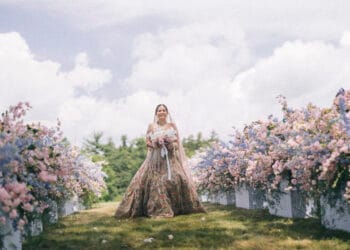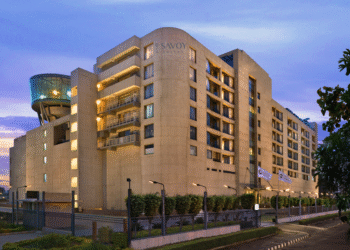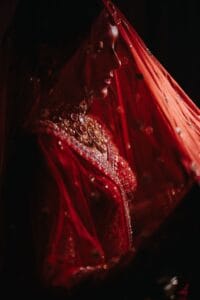
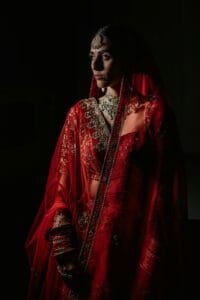
India’s wedding industry, a $130 billion powerhouse, is among the largest in the world, and for many, the bridal outfit remains its sparkling centrepiece. But today, bridal fashion is not only about the grandeur of the lehenga or the dazzle of jewellery, but also about storytelling, sentiment, and self-expression. From sunlit castles in Italy to opulent mandaps in Rajasthan’s forts, Indian brides are redefining what it means to be timeless, personal, and unforgettable, says Jyoti Verma.
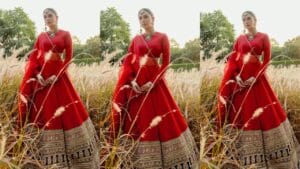
Until a few years ago, Indian bridal wear typically meant heavy silks, ornate embroidery, and the classic red palette. But the Indian bride of 2025 is more than a silhouette steeped in tradition, she is individualistic, mindful, and globally inspired. Whether it’s an ivory silk Sabyasachi sari with a fishtail hem or a Kanjeevaram tailored for a beach ceremony, bridal wear today reflects personal philosophy as much as it does heritage.
Consider Tanika D’Souza, who wore a subtle, intricately embroidered ivory Sabyasachi sari for her destination wedding in Italy this March. Complete with a sheer veil and minimal jewellery, her look embodied modern bridal elegance, where couture meets cultural storytelling and tradition meets global sensibility. Tanika represents the contemporary Indian bride who wants it all, a bridal look that’s intimate, international, and effortlessly elegant. Sabyasachi delivered, as always, with his signature blend of restraint and regality.
In Red We Trust
Young brides like D’Souza aren’t alone. India’s celebrated brides are leaning into meaning over momentary trends. Aditi Rao Hydari wore a regal red silk lehenga for her royal wedding in Rajasthan, Sobhita Dhulipala chose a red Kanjeevaram for her Pelli Kuthuru ceremony in Visakhapatnam, and Rakul Preet Singh embraced a sindoor-inspired palette of orange, pink, and red for her mehendi. These choices reflect a growing preference for heritage, symbolism, and personal storytelling.
A common, interesting trend in these celebrity wedding events is the choice of the red colour. Once eclipsed by the pastel revolution sparked by Anushka Sharma’s pale pink lehenga in 2017, red is making a striking comeback. As designer Sabyasachi famously said, “Red is not seasonal, it’s iconic.” Designers like Tarun Tahiliani, JJ Valaya and Gaurav Gupta also continue to champion the boldness of red in all its shades. Yet today’s bride isn’t confined by a single hue. From deep reds to mustard gold and midnight blue, the colour spectrum mirrors her many moods.
Elegance Over Excess
Today’s bridal look is guided less by minimalism or maximalism and more by meaning. Designers understand that a modern bridal outfit needs to be elegant, memorable, and above all, wearable. Customisation, comfort, and legacy are now the touchstones.
Gone are the 17-pound lehengas. Brides are choosing lighter, more fluid silhouettes. Entry-level saris are thriving. Heritage craft remains at the heart of Indian bridal fashion, but designers are pairing it with bold colours and feather-weight fabrics to make even the most ornate ensembles deceptively light.
“People in their 20s are throwing out the rulebook,” said designer Abu Jani at the recent launch of his Mumbai store. “They want their garments to reflect who they are.” This mindset is reshaping bridal wear too, shifting the focus from fast fashion to keepsake couture, and creating dresses that are as emotionally resonant as they are exquisite.
Guided by this shift, leading bridal labels are reinterpreting tradition with a contemporary eye. Time-honoured embroidery techniques are being applied to modern silhouettes. Handwoven brocades, intricate zari and luminous silk tissues are layered tone-on-tone, creating a look that feels both opulent and restrained. Personalisation adds the final touch, with heirloom dupattas, vintage odhanis, and initials discreetly embroidered along a border.
And it’s not just the outfit. Accessories are undergoing their own quiet revolution. Manish Malhotra’s new jewellery line includes necklaces, brooches and collar pins, for both bride and groom. On the footwear front, comfort reigns. Brides are choosing handcrafted shoes that marry couture with practicality. Bridal sneakers are on the rise, often personalised with initials, wedding dates, or delicate motifs that tell their own story.
Destination Meets Design
As destination weddings grow in popularity, bridal fashion is evolving accordingly. Brides want footwear that can move from Rajasthani courtyards to Tuscan terraces with ease. Floral embroidery and sustainable materials are in vogue, reflecting an increasing eco-consciousness. Designers are responding with modular lehengas, convertible dupattas, and silhouettes that travel well. Gaurav Gupta’s sculptural gowns and concept saris, part architectural and part fantastical, are now staples for cocktail nights and after-parties.
With over ten million weddings annually, India’s bridal market is thriving not because of scale alone, but because of its evolving soul. The new energy is coming from authenticity. Young designers, stylists, and legacy houses are not just elevating craftsmanship, they are giving every garment a voice.
“Brides today want their clothes to tell a story,”said stylist Anaita Shroff Adajania in a recent interview. That narrative might be woven into a Kanjeevaram, stitched into a corset blouse, or whispered through a sheer veil trailing behind a confident stride.
In 2025, the Indian bride is everything at once, classic and contemporary, bold and soft, rooted and free. And the fashion she chooses is not just worn, it is lived.
Follow BOTT on LinkedIn, Facebook, Twitter & Instagram
Subscribe BOTT Channels on WhatsApp & Telegram to receive real time updates

